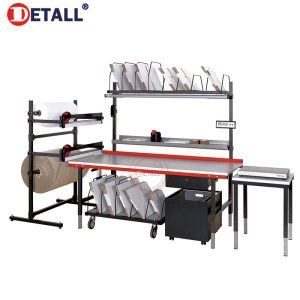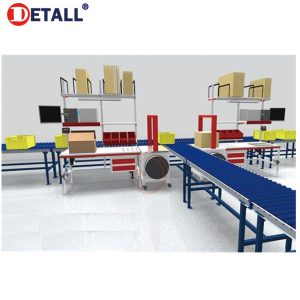How Is a Packing Table Different from a Regular Workbench?
Introduction
If you're building a warehouse, fulfillment station, or even a compact packing area at home, you might wonder:
"Can I just use a regular workbench for packing?"
The short answer is—not quite.
While both packing tables and standard workbenches offer a surface to work on, they’re designed for very different purposes. A packing table is built specifically for the demands of order fulfillment: speed, accuracy, organization, and comfort. This blog explores the unique features of packing tables, how they differ from ordinary workbenches, and which setup might best suit your operations.
What We’ll Cover
- Core Features of a Packing Table
- Key Differences Between Packing Tables and Workbenches
- Why Ergonomics Matter in Packing Stations
- Tech Integration in Modern Packing Tables
- When a Workbench Might (or Might Not) Be Enough
1. Core Features of a Packing Table
A thoughtfully designed packing table is much more than a flat surface. It acts as a central command station, giving you quick access to everything needed to fulfill orders efficiently. Key features often include:
- Built-in shelving for tape, boxes, and packing slips
- Integrated cutter rail for clean and quick cutting of packaging materials
- Support rods for holding packaging roll materials (kraft paper, bubble wrap, etc.)
- Hooks for tape dispensers and handheld tools, keeping the surface tidy
- Side or lower-tier platforms for storing filling machines or void fill bags
- Cut-resistant mats to protect products and the tabletop
- Monitor, CPU, and keyboard mounts for managing digital order systems
- Label printer shelf or integrated printing area
💡 User Tip: All these design elements allow packing tasks to be completed directly at the table, reducing unnecessary movement, preventing interruptions, and saving valuable time. A true packing station minimizes motion and maximizes output.
2. Packing Table vs. Regular Workbench: Key Differences
Many businesses initially use a generic workbench for packing. While it might function temporarily, the lack of specialized packing features quickly becomes a productivity bottleneck.
| Feature/Function | Packing Table | Regular Workbench |
|---|---|---|
| Application | Fast, organized, efficient packing | General-purpose use |
| Storage Integration | Built-in shelves, under-table bins, tape hooks, side trays | Basic drawers or open shelves |
| Material Access | Roll holders, cutter bars, fill station support | None |
| Tech Compatibility | Monitor arms, CPU brackets, keyboard trays, printer holders | Lacks mounting and cable management |
| Ergonomic Features | Adjustable height, anti-fatigue footrests | Fixed height, basic structure |
| Workflow Optimization | Designed for repetitive, high-speed fulfillment | Not optimized for packing tasks |
3. Why Ergonomics Matter in Packing Stations
Packing isn't a one-time task—it's repeated dozens or even hundreds of times per day. Packing tables offer ergonomic benefits that typical workbenches don't, such as:
- Adjustable height to reduce back strain during long shifts
- Reach-optimized layout, minimizing awkward postures and repeated stretching
- Angled keyboard trays and monitor mounts for ideal posture
- Anti-fatigue mats underfoot for standing comfort
💡 User Tip: Many warehouses report fewer repetitive strain injuries and higher employee satisfaction after switching to ergonomic packing tables.
4. Integration with Tools and Technology
Today’s e-commerce workflow is highly digital. A modern packing table seamlessly integrates with the tech you need:
- Dedicated monitor mounts for real-time order dashboards
- CPU brackets or under-desk shelves to safely secure hardware
- Sliding keyboard trays to free up space and reduce clutter
- Label printer platforms for quick access to shipping labels
- Cable routing systems and power strip channels for safety and convenience
💡 Use Case: A tech-integrated packing table reduces labeling errors, improves accuracy, and enables paperless, streamlined operations.
5. When a Regular Workbench Might Work (But Rarely Does)
If your order volume is extremely low or you’re in the prototyping phase of your business, a regular workbench may suffice temporarily. But keep in mind:
- You’ll need to add shelves, hooks, and platforms separately
- Tool clutter and poor cable management will slow you down
- Poor ergonomics could lead to fatigue or injury
- There’s no designated space for packaging materials like roll wrap or fillers
💡 Reality Check: As soon as your daily order volume grows, the shortcomings of a standard workbench become productivity blockers.
Conclusion
Packing tables are designed by and for professionals who need an efficient, repeatable, and comfortable way to pack and ship products. They’re not just upgraded benches—they're task-specific workstations that pay for themselves in time saved and operational consistency.
With the right packing table setup—including:
- Cutter bars and roll holders
- Side platforms for filling machines
- Monitor and keyboard integration
- Hooks for tape guns and tools
—you'll create an optimized packing environment that helps you scale smarter and operate more efficiently.



